Calculated Metrics is a new feature that has been rolled out in Google Analytics 4. It enables you to create formulas using GA4’s standard and custom metrics to generate the specific data you need for monitoring and improving your performance marketing campaigns.
In this article, you’ll learn how to use GA4 Calculated Metrics for your business, including how to set them up, their current limitations, and how to report on and interpret your Calculated Metrics data.
What are GA4 Calculated Metrics?
Calculated Metrics combine existing metrics within your GA4 property to give you better visibility and easier access to the data at your fingertips. According to Google:
“Calculated metrics are metrics that combine one or more existing or custom metrics within a mathematical formula to produce a new and potentially more valuable metric. With calculated metrics, you can adjust any metric to fit your business needs or logic. You can weight or discount existing metrics and create new metrics by combining standard and/or custom metrics.”
For example, you could use GA4 Calculated Metrics to determine:
- Shipping costs as a percentage of purchase revenue.
- Number of active or inactive users on your website.
- Estimated profit based on total revenue.
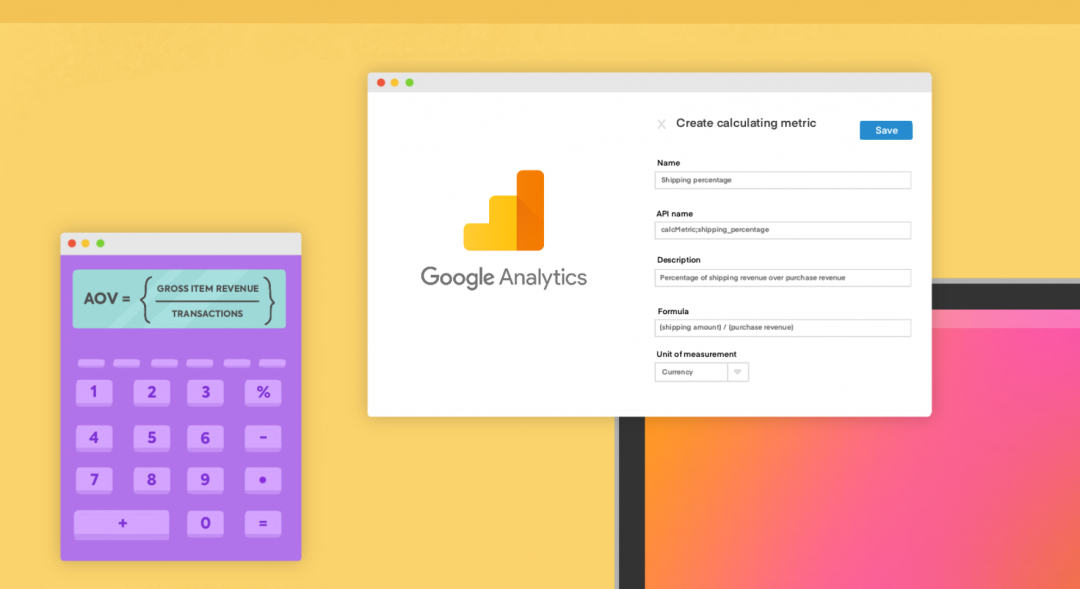
What’s the difference between Custom Metrics and Calculated Metrics?
In GA4, your Calculated Metrics will often appear under Custom Metrics tabs and headings. Both Custom and Calculate Metrics allow you to create bespoke datasets, but they use different properties. Compare the differences in the table below:
Custom Metrics allow you to store data that’s not automatically collected in GA4 (such as phone enquiries) and to organise your GA4 data in a way that’s useful for you. Calculated Metrics, meanwhile, combine or manipulate existing metrics and information to generate new valuable data you can use to reach your advertising KPIs.
Unlike Custom Metrics, Calculated Metrics depend on the values of other metrics. While you can use Custom Metrics to create a Calculated Metric, you can’t use Calculated Metrics within other Calculated Metrics.
How to create Calculated Metrics in GA4
Here’s a step-by-step guide to creating Calculated Metrics in Google Analytics 4.
1. Select your GA4 property and navigate to Admin. Then select Custom Dimensions in the Property column.
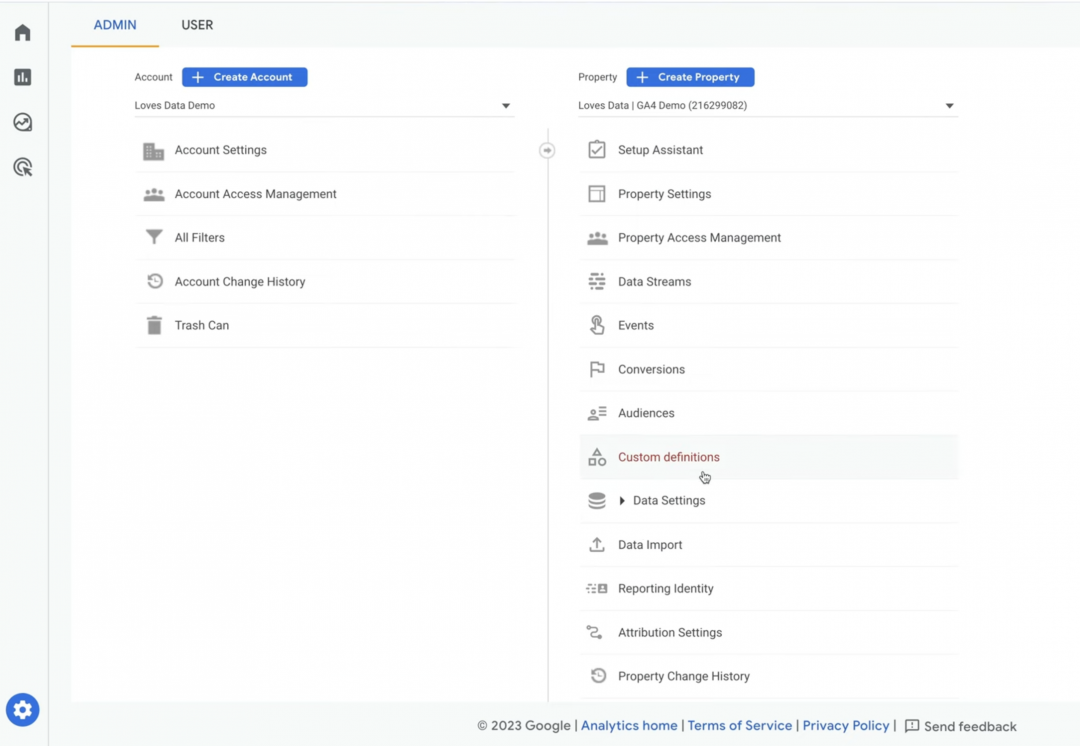
2. Click on the Calculated Metrics tab to see existing metrics, or create a new one.

3. To create a new Calculated Metric, you’ll need Administrator or Editor access to your GA4 property. Once you have the right permissions, click the Create Calculated Metric button to get started.
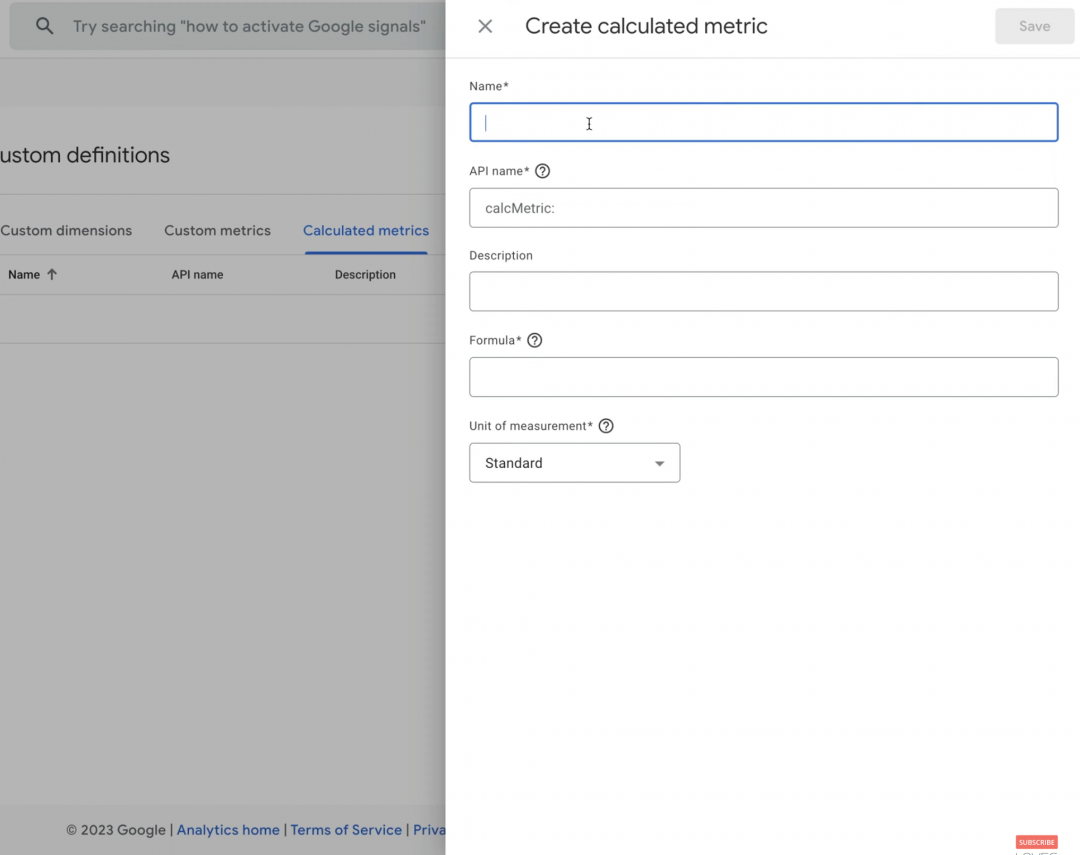
4. Add a suitable name for your metric based on what you’re calculating. In this example, we’ll create a Calculated Metric to measure the number of inactive users on the site.
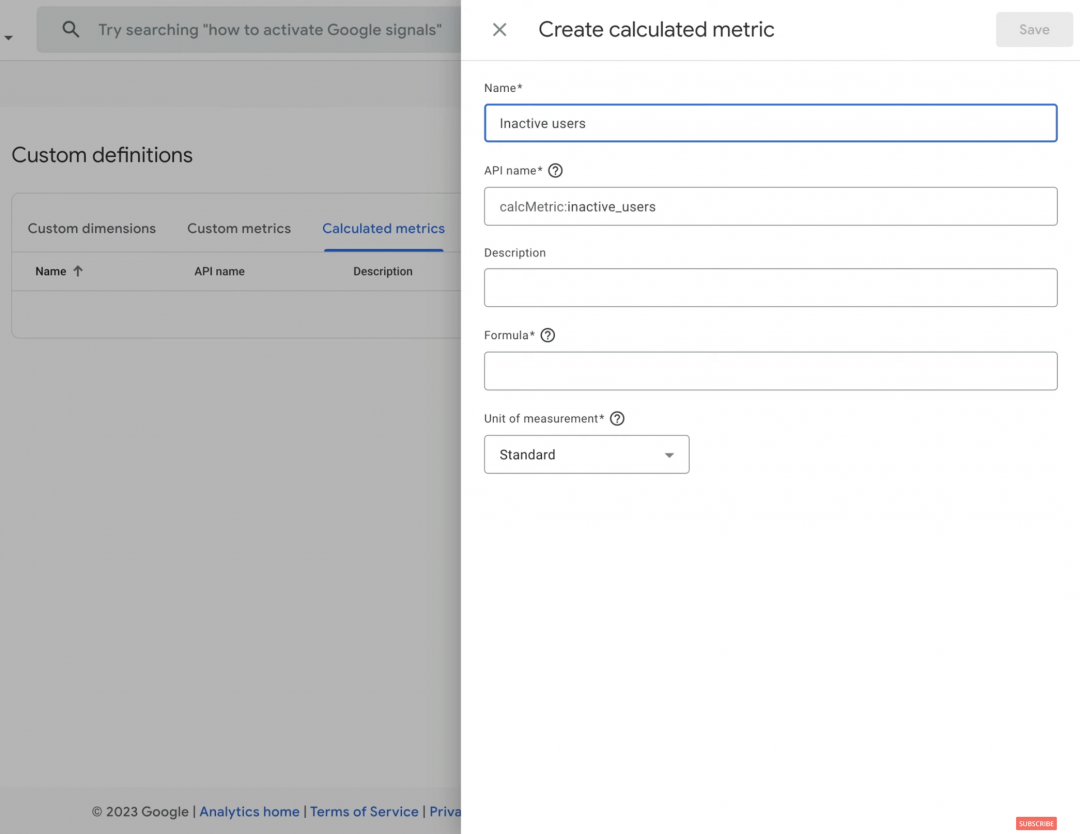
When you add the name, the API name will be automatically populated. You don’t need to make any changes to this field.
5. Add a relevant description to provide any useful additional information.
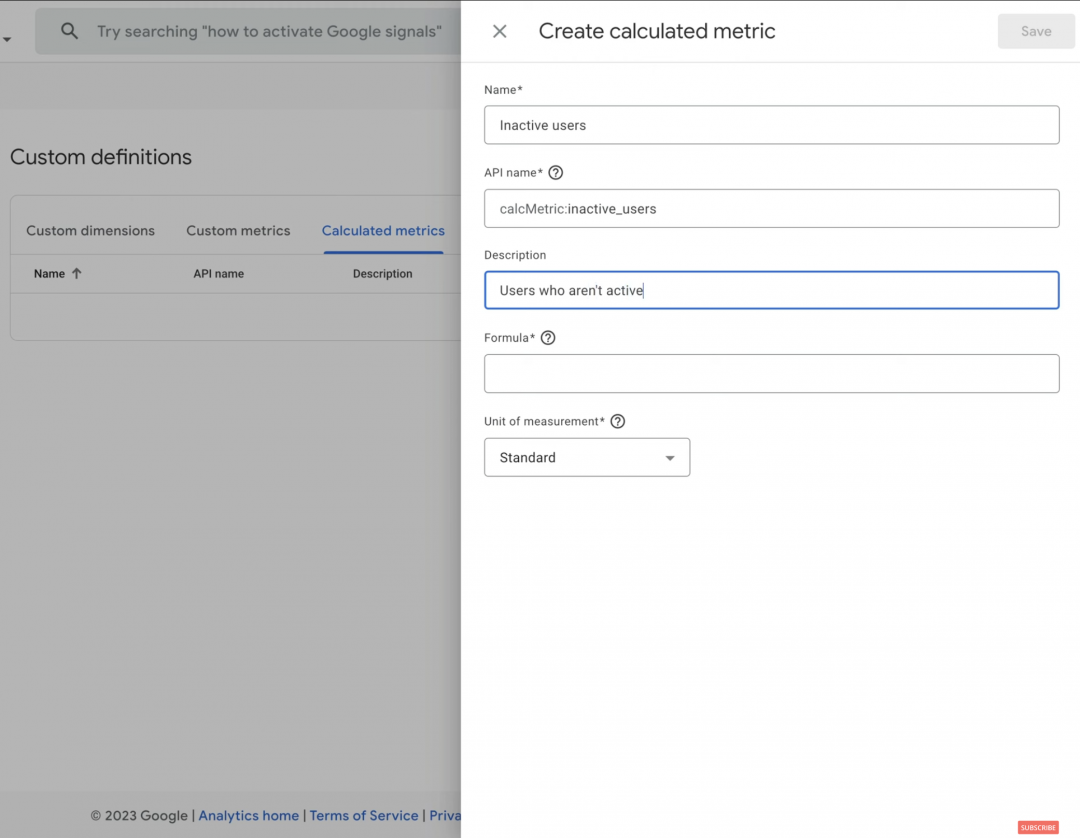
6. Add the formula. You’ll need to know which standard or custom metrics are required to give you the information you need. For this example, we’ll subtract Active Users from Total Users to give us the number of inactive users.
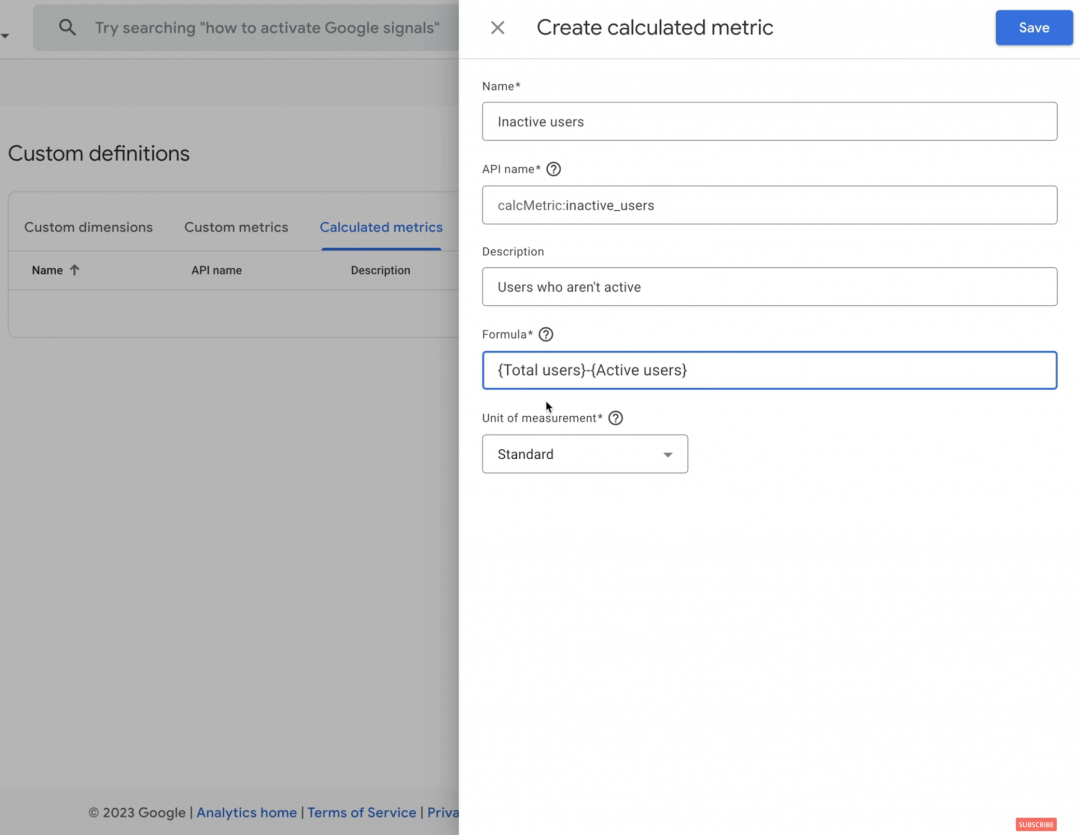
To create your formula, use the same mathematical symbols you would use in Excel or other spreadsheet programs. You can also use numbers to work out specific percentages or counts.
1. Select your unit of measurement. GA4 offers several options here, including Standard, Currency, and Distance. Choose the unit that’s most appropriate for the metric you’re creating.
2. Click Save to create your Calculated Metric and return to the Custom Definitions page. You’ll see your newly created metric in the list.
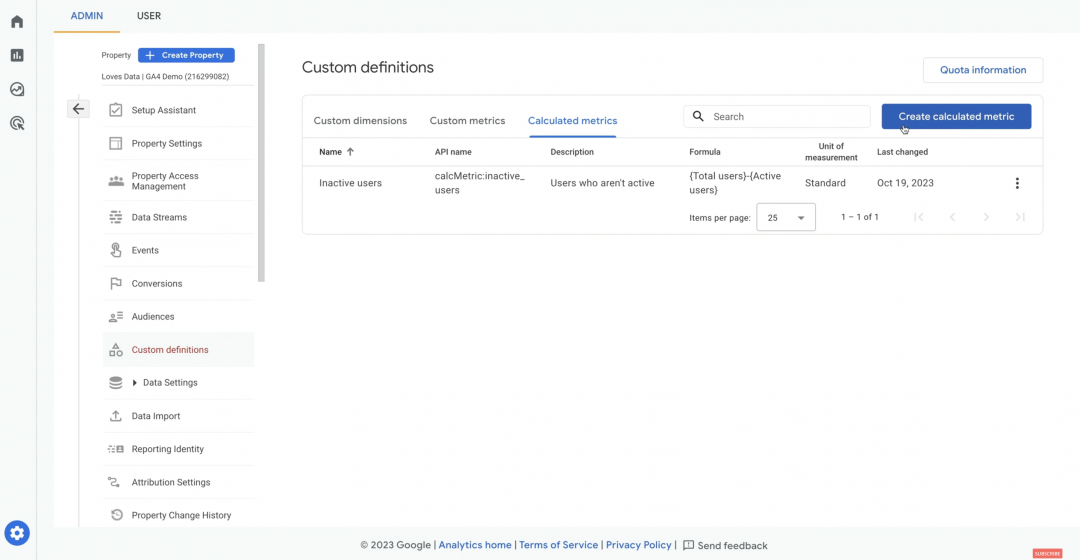
3. You can edit, archive, or copy your Calculated Metric at any time by clicking the three dots menu next to it.
Watch the video below for a walkthrough of how to create Calculated Metrics in GA4:
Examples of Calculated Metrics
We’ve looked at a few ways you can use GA4 Calculated Metrics already, but let’s explore a few more popular use cases for this feature. In the table below, you’ll find nine examples of Calculated Metrics, including formulas and measurement units you need.
Note: The number in the formula reflects the current exchange rate from GBP to USD. It will fluctuate from day to day, but can give you a general idea of your revenue in USD. You can replace this number with the exchange rate for any chosen currency.
Accurate shipping costs, for example, are vital when it comes to tracking important metrics such as POAS (profit on ad spend). We recently spoke to Google Ads expert Adriaan Dekker about all things POAS on the Paid Media Lab podcast:
Aside from accurately tracking important metrics such as POAS, there are limitless opportunities for using GA4 Calculated Metrics in your performance marketing efforts. So how do you know which Calculated Metrics are most useful for your business?
Conversion optimisation and revenue growth specialist Natasha Vorompiova says:
"When you are thinking about metrics to build, you should think about the action that you will be able to take by knowing this number. Calculated Metrics allow us to tailor our metrics to our business needs, so as you think about metrics that will allow you to take that action, now there is a way to do it."
Natasha Vorompiova
Conversion Optimisation Specialist
Limitations of GA4 Calculated Metrics
While Calculated Metrics can be invaluable for performance marketers, there are some limitations to note:
1. You can only create up to five Calculated Metrics in standard GA4 properties. So consider which metrics are going to bring you the most value. Google Analytics 360 users can create up to 50 Calculated Metrics.
2. There are some known bugs in GA4 which can affect results. Using certain metrics in your calculations can throw up some issues, so you may need to find a workaround if your results don’t look as you expected.
3. Google restricts certain metric combinations. Some metrics can’t be used in formulas with specific other metrics, which limits some of the calculations you can make. Benjamin Mangold, co-founder at Loves Data, says:
"I find this a bit frustrating because this is something we could do in Universal Analytics, which was the previous version of Google Analytics. Hopefully this changes soon in the new version [of GA4]."
Benjamin Mangold
Co-Founder, Loves Data
4. Not all Custom Metrics and standard metrics are available for selection. Certain metrics, like Exits, can’t yet be used to generate Calculated Metrics.
5. Only Admins and Editors can create GA4 Calculated Metrics. You may need to adjust your permissions settings accordingly.
6. You can’t use other Calculated Metrics to create new Calculated Metrics. Only standard and custom metrics can be incorporated into your Calculated Metric formula.
7. Formulas are limited to 1024 characters. While most basic formulas won’t need this many characters, you may need to use other tools for more advanced calculations.
8. Calculated Metrics round up amounts into whole numbers. It’s not currently possible to change the number of decimal places you see in your reports, so your data might not be as accurate as you’d like.
Most of these limitations won’t stop you using Calculated Metrics to their full potential. Just make sure to monitor your results closely so you can identify anything that doesn’t look right. You can change your formulas at any time to ensure you’re seeing accurate data in your reports.
Adding Calculated Metrics to reports
There are two ways to add Calculated Metrics to your GA4 reports. First, you can add them to your standard reports.
To do this, navigate to the report you want to change and click the Customise Report pencil icon. Select Metrics, then find your chosen Calculated Metric in the Add Metrics field:
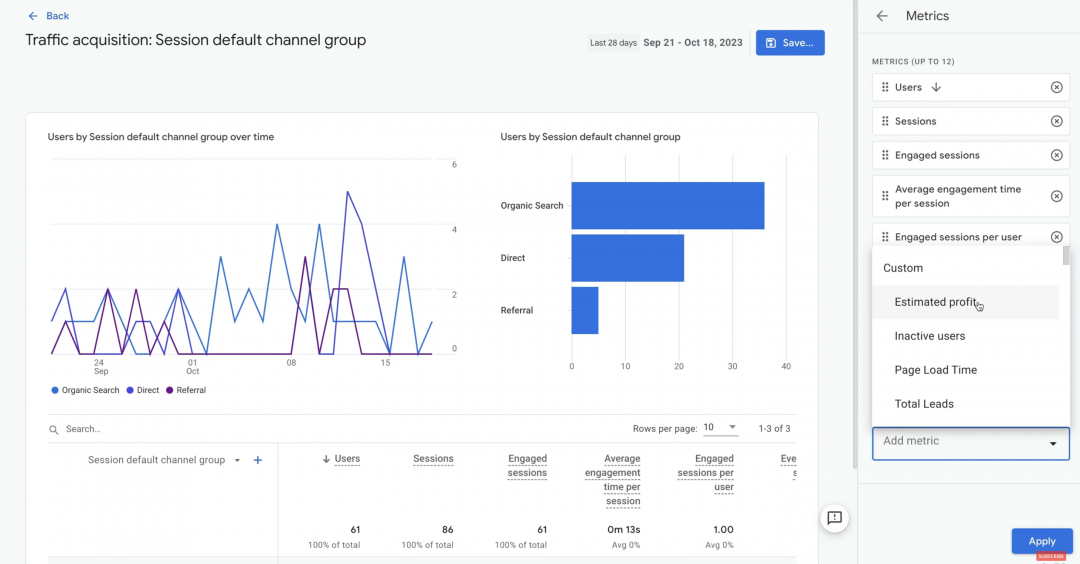
Alternatively, create a new report in the Explore section of GA4. Create a blank report, name it, then click the + icon next to Metrics. This will bring up a list of all available metrics.
Under Custom, select your chosen Calculated Metrics (plus any other relevant metrics) and click Import.
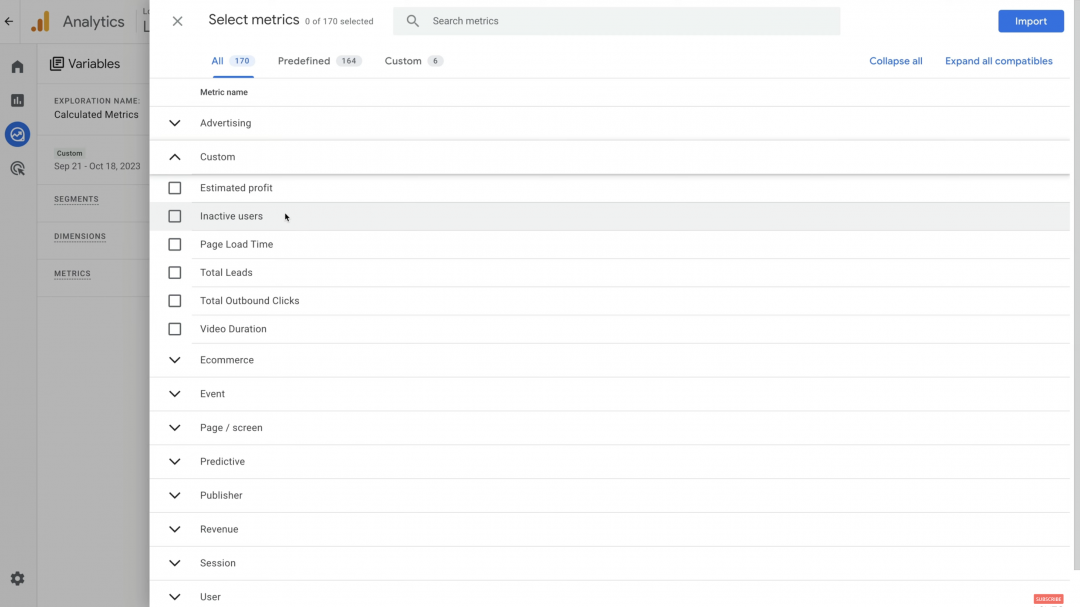
This will add the metrics to your list. Click on them in the left hand panel to bring them into your report.
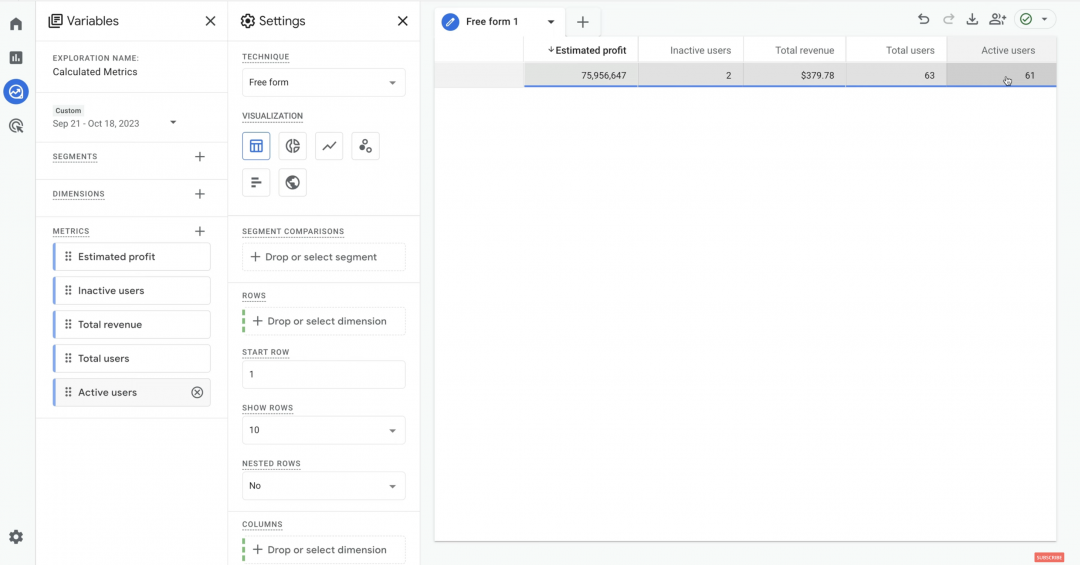
You can now see the data being generated by your Calculated Metrics to check its accuracy. If it seems right, you can start using this information to inform current and future campaigns.
If there are any anomalies, head back to the Admin page to adjust your formulas until you have accurate, reliable data.
Interpreting Calculated Metrics data
Calculated Metrics data can be very useful in its own right. But when you combine it with other data from your GA4 property, you can get even more useful insights. Let’s take a look at how to effectively interpret your Calculated Metrics data.
To get the most from your Calculated Metrics, combine it with relevant dimensions. For example, the Page Path + Query String dimension shows you the metric values for each page on your website:

In this example, you can see which pages have a lower percentage of active users. You may want to use this data to improve the user experience on pages with lower active users, or redirect them to more engaging pages. Natasha says:
"This is the same logic you can use when you think about which Calculated Metrics to build. They will be your indicators of how well things are working, and what action you can take next based on this. The insights you receive are a bit more refined."
Natasha Vorompiova
Conversion Optimisation Specialist
That’s why it’s important to know how you’ll use your Calculated Metrics data before you set up your reports. Look to generate data that will allow you to improve your performance marketing, so you can get the most value from this new GA4 tool.
Keep your GA4 Data clean and reliable with Lunio
Many performance marketers rely on Google Analytics 4 to give them clean, accurate data they can use to make informed decisions about current and future campaigns.
But your GA4 data can easily be skewed if you have an invalid traffic problem. According to our Wasted Ad Spend Report 2024, more than 42% of performance marketers are worried about the impact of invalid traffic on their ad spend and analytics data.
Excluding invalid traffic stops GA4 being infiltrated by bad data. It reduces the number of fake lead submissions and stops you wasting ad spend on fake users or bots, so you can focus 100% of your budget on reaching the most promising potential customers.
See how much invalid traffic is affecting your analytics platform with Lunio’s free two-week-trial. Request a demo to get started.
Say goodbye to wasted ad spend
Discover how Lunio can help you eliminate invalid ad clicks and maximize paid media performance









.png)





